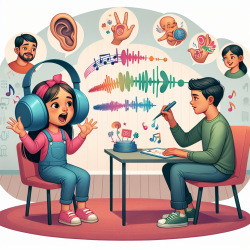Introduction
In the realm of speech-language pathology, the integration of emotional processing into therapeutic interventions is gaining traction. A recent study, "Invoking the influence of emotion in central auditory processing to improve the treatment of speech impairments," provides compelling evidence that emotional stimuli, particularly when delivered by familiar voices, can significantly enhance therapeutic outcomes for children with speech impairments. This blog explores the study's findings and offers practical insights for practitioners aiming to optimize speech therapy outcomes for children.
The Study at a Glance
The study involved 80 participants with speech issues, divided into two groups: those with misarticulation and those with stuttering. The research aimed to assess the impact of emotional auditory stimuli on speech therapy outcomes. Participants were exposed to speech stimuli recorded by both familiar and unfamiliar voices, in emotional and non-emotional contexts. The results were telling: familiar voices in emotional contexts significantly reduced stuttering errors and increased the percentage of correctly pronounced sounds in articulation disorders.
Key Findings
- Stuttering errors were reduced to 3% with familiar voices in emotional contexts, compared to 12% with unfamiliar voices.
- Correct pronunciation in articulation disorders increased to 88% with familiar voices in emotional contexts, compared to 66% with unfamiliar voices.
- The study highlights the importance of engaging family and friends in the therapeutic process to enhance emotional relevance and familiarity.
Implications for Practice
For practitioners, these findings underscore the value of incorporating familiar voices into therapy sessions. Here are some practical steps to consider:
- Engage Family Members: Encourage parents and siblings to participate in therapy sessions by recording therapeutic materials. Their voices can provide the emotional familiarity needed to boost therapy outcomes.
- Utilize Emotional Contexts: Incorporate emotionally relevant stimuli into therapy sessions. This can include using emotionally charged words or phrases that resonate with the child's experiences.
- Monitor Emotional Responses: Pay attention to the child's emotional responses during therapy. Adjust the emotional intensity of stimuli based on the child's comfort level and progress.
Encouraging Further Research
While the study provides a strong foundation, further research is needed to explore the long-term effects of emotional auditory processing in speech therapy. Practitioners are encouraged to contribute to this growing body of knowledge by documenting their experiences and outcomes.
Conclusion
The integration of emotional processing into speech therapy holds promise for improving outcomes in children with speech impairments. By leveraging familiar voices and emotional contexts, practitioners can create more effective and engaging therapeutic experiences. To delve deeper into the original research, please follow this link: Invoking the influence of emotion in central auditory processing to improve the treatment of speech impairments.










